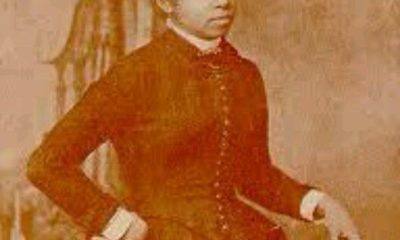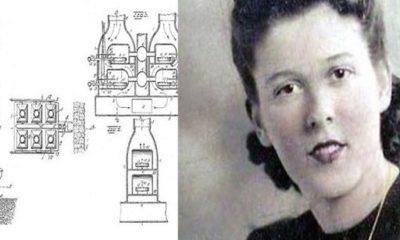Featured
Jan Ernst Matzeliger: The Man Who Revolutionized the Shoe Industry

February is Black History Month. And what better way to celebrate than to lift from obscurity African Americans who played crucial roles in this country’s scientific, cultural and industrial progress. Their achievements saved thousands of lives, made the lives of many Americans easier and in some instances changed the course of history. And yet, they are largely forgotten by the world they helped to change for the better. In this series, we will highlight some of these under-appreciated and forgotten men and women.
They told him it could never be done. They even mocked him. But Jan Ernst Matzeliger gave his life to prove them wrong when he invented a machine that revolutionized the shoe industry worldwide.
Matzeliger was born on a coffee plantation in Paramaribo, Surinam (Dutch Guiana) to a house slave on Sept. 15, 1852. His father, the plantation owner, owned and operated the Colonial Ship Works that had been in his family for three generations. At 10-years-old, Matzeliger reportedly started working as an apprentice at the company in Paramaribo, where he demonstrated a natural aptitude for machinery and mechanics. He left at 19 and after working on a ship for about two years ended up in Philadelphia, Penn., according to Louis Haber, author of Black Pioneers of Science and Invention.
But finding little opportunities for Black people there, he eventually left and settled in Lynn, Mass. A town of about 35,000 people, Lynn was the largest shoe manufacturing center in the country in a state that was responsible for more than half the shoes produced in the United States at that time, Haber said.
Because of his knowledge in mechanics and cobbling, Haber said Matzeliger, who spoke little English and never had any kind of formal education, was able to find jobs working on different kinds of machines used in making shoes.
Still, there was no machine for connecting the “uppers” to the soles of the shoe. This was done by hand, which meant the work would pile up since the first part was done by fast machines. No one in the industry believed a machine could be invented to complete the task. Matzeliger, who went to evening school to learn English and from his meager earnings bought books on Physics and other subjects, saw this as a challenge.
“Although men jeered at him for thinking he could invent such a machine and many a joke was turned at his expense, Matzeliger was not deterred,” Haber said.
He would watch the hand lasters, as they were called. They would stretch the leather into place at the toe and heel for the final tacking operations. His machine would have to duplicate the movements of their fingers. Once he learned their technique, he rented a cheap, cold room where he experimented at night after working long hours during the day at his job. He used scrap materials such as pieces of wood and old cigar boxes as well as improvised tools and after six months had a crude model, Haber said. Someone offered him $50 for it. He refused and kept working to come up with a better model. With no money to hire help, he did all the filing, forging and fitting himself, Haber said.
“For years he lived on very little, spending no more than five or six cents a day on food, in order to save money for his project,” Haber said.
But Matzeliger simply didn’t have enough money to finish and sought financial backing. He received it in exchange for two-thirds interest in the invention, Haber said. Finally, Matzeliger succeeded and in 1883 obtained a patent for his invention – a lasting machine that pulled the leather down around the heel, set and drove in the nails, and then discharged the completed shoe. In a factory test, the machine could complete 75 pairs of women’s shoes in one day, Haber said. Later, the machine was made to turn out 150 to 700 pairs of shoes in one day, according to online reports. An expert hand laster could only produce about 50 pairs in a 10-hour day, Haber said.
“The shoe industry had indeed been revolutionized,” Haber said. Matzeliger, who had no formal education, had achieved the impossible. His machine greatly increased shoe production and cut the cost of shoe in half. By 1889, there was a worldwide demand for the lasting machine. The company that sponsored him would earn millions in the following years. By 1955, its capitalization was over a billion dollars, Haber said.
But by then, Matzeliger was no longer around.
“Because of his long and hard work, day and night, and lack of proper food and warmth because of his extreme poverty, Matzeliger’s health suffered,” Haber said. “In the summer of 1886 be contracted a cold which, due to his low resistance turned into tuberculosis.”
He remained bedridden for three years and never recovered. On Aug. 24, 1889, Matzeliger, who was described as cheerful and kindhearted, honest and friendly, died three weeks before his 37th birthday.
In 1991, the United States government issued a “Black Heritage” postage stamp in Matzeliger’s honor, according to Biography.com. Also, Russian engineers who came to the United States to study modern shoe production after the Russian Revolution learned about Matzeliger’s work. They were so impressed that, according to Haber, they wrote and published Matzeliger’s story in their own language.

-

 Featured10 months ago
Featured10 months agoCalifornia Is the First State to Create A Public Alert for Missing Black Youth
-

 Featured9 months ago
Featured9 months agoAfrican American Leaders Stay the Course Amid Calls for President Biden To Bow Out of Race
-

 Featured10 months ago
Featured10 months agoThe Debate Fallout Lands on Both Candidates
-

 Featured9 months ago
Featured9 months agoPresident Joe Biden Decides to Withdraw from the Presidential Race
-

 Featured9 months ago
Featured9 months agoIn One of His Final Speeches as President, Biden Says It’s Time for ‘Fresh Voices’
-

 Featured9 months ago
Featured9 months agoPresident Joe Biden Describes Shooting of Donald Trump As ‘Sick’









